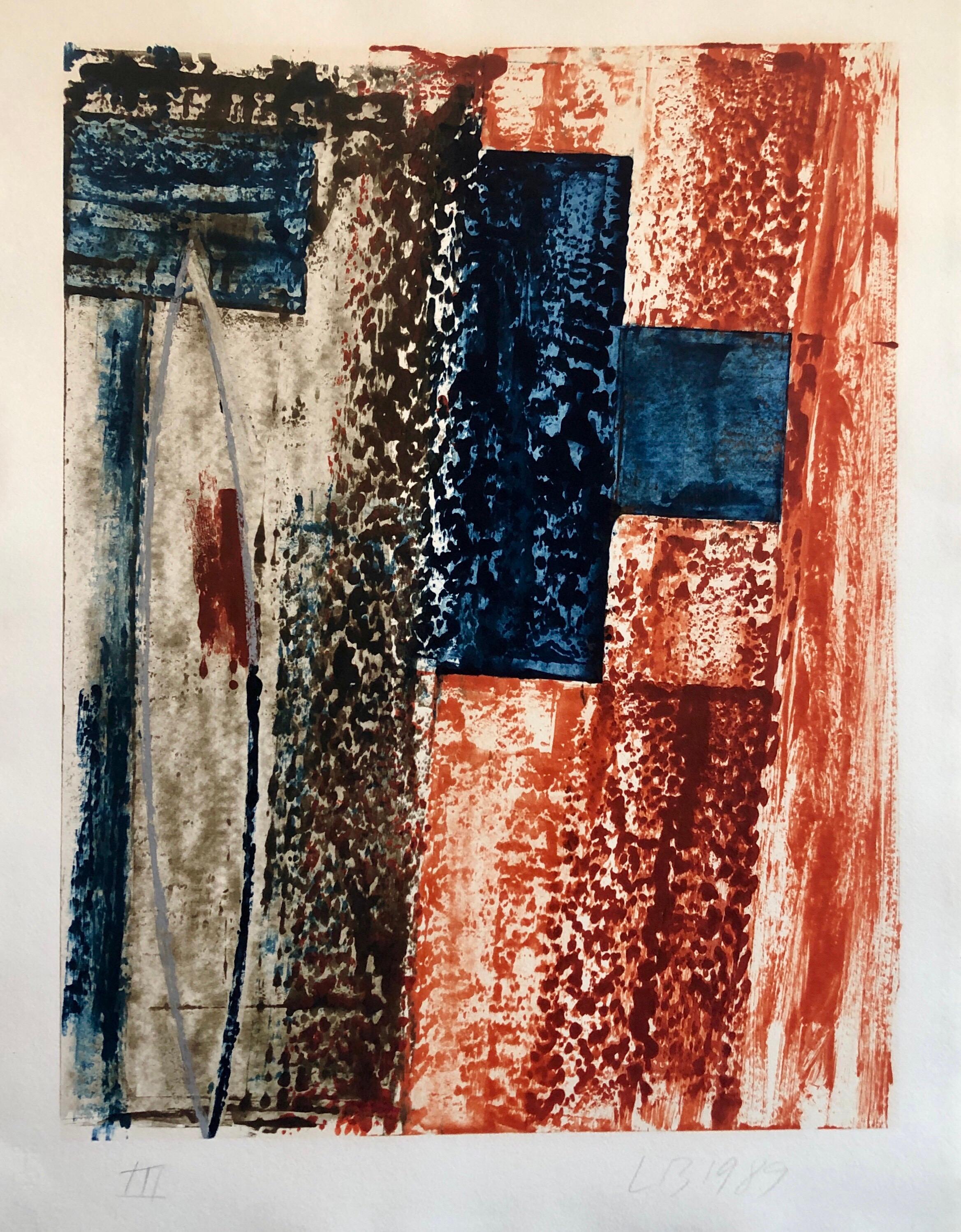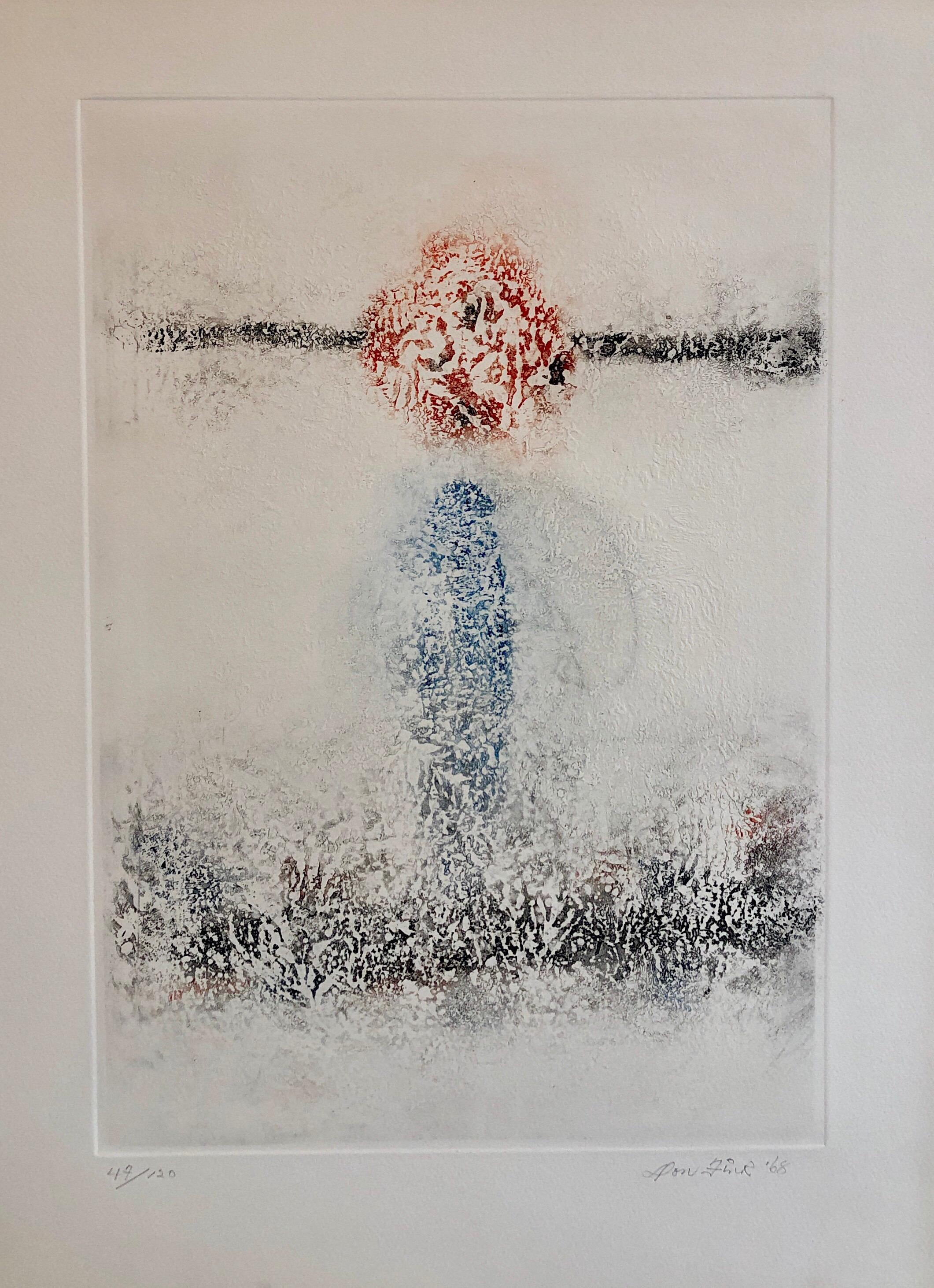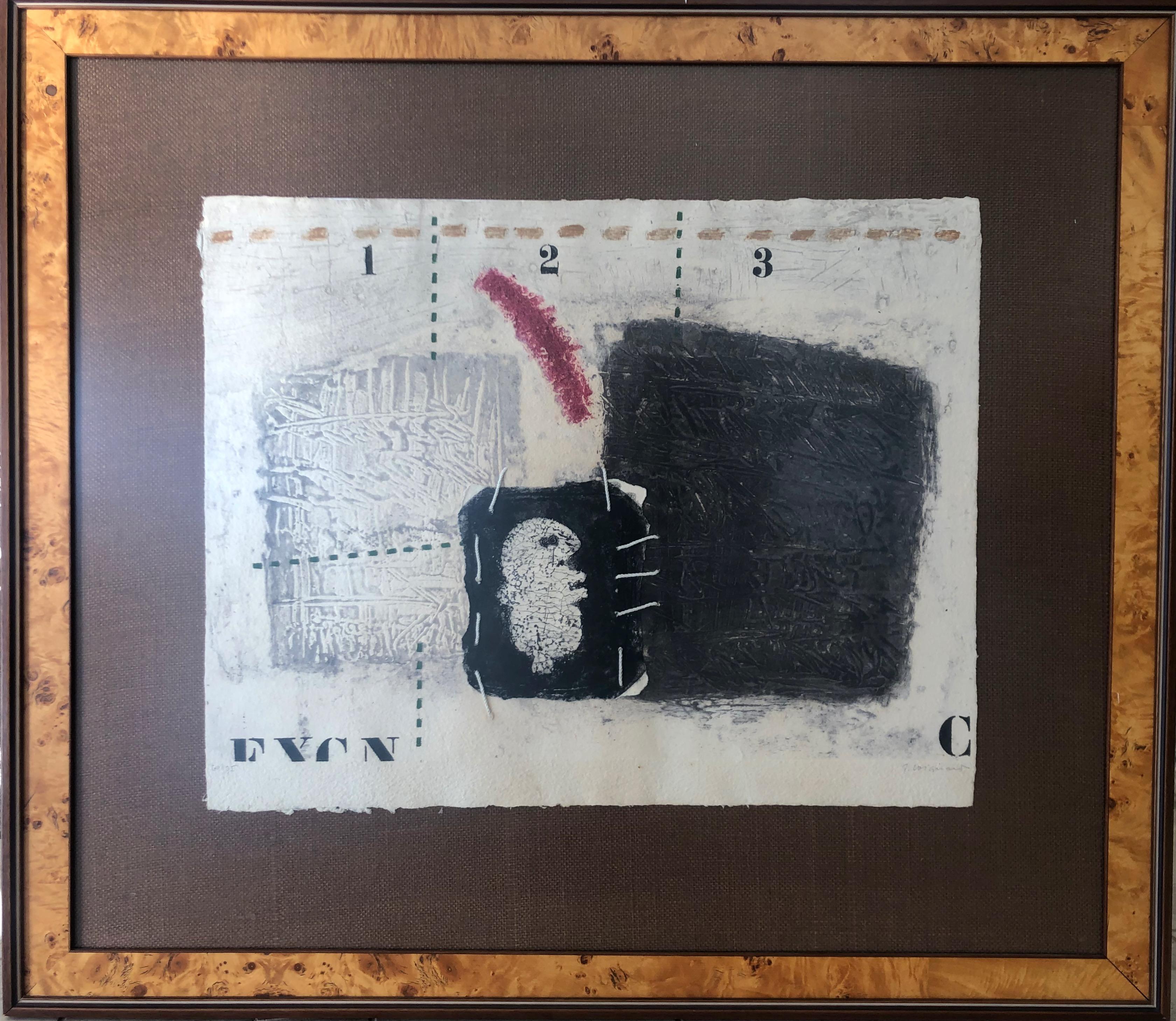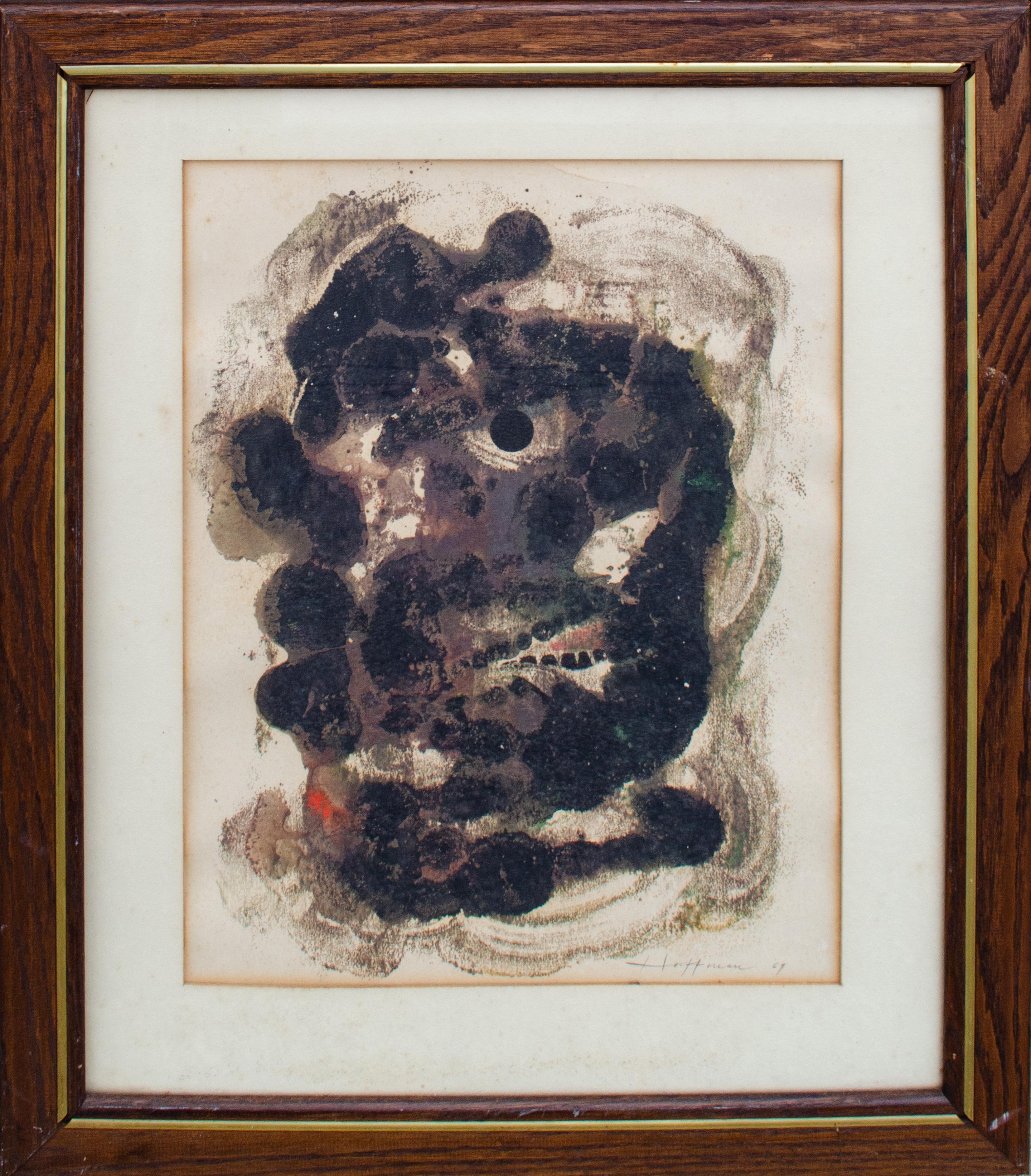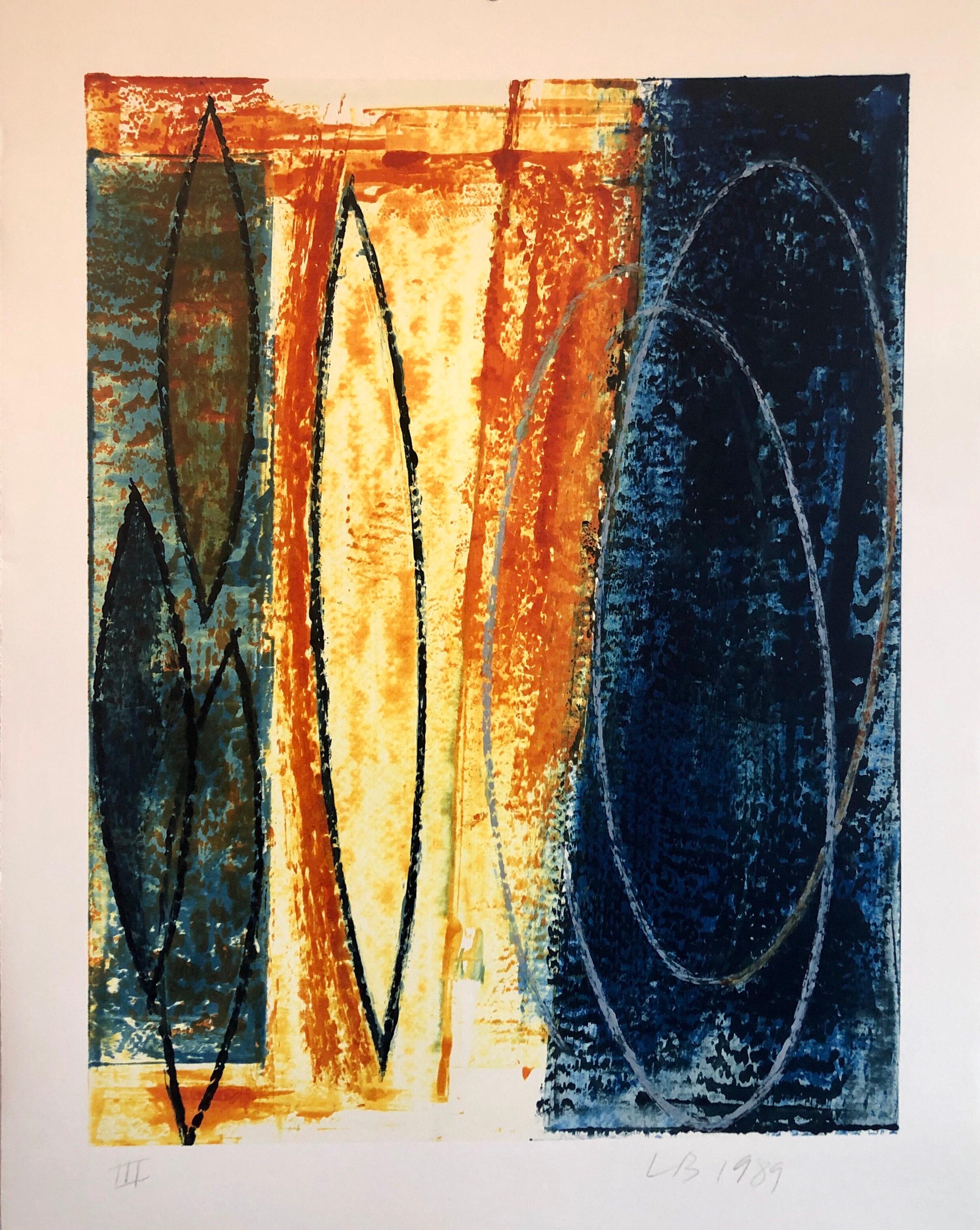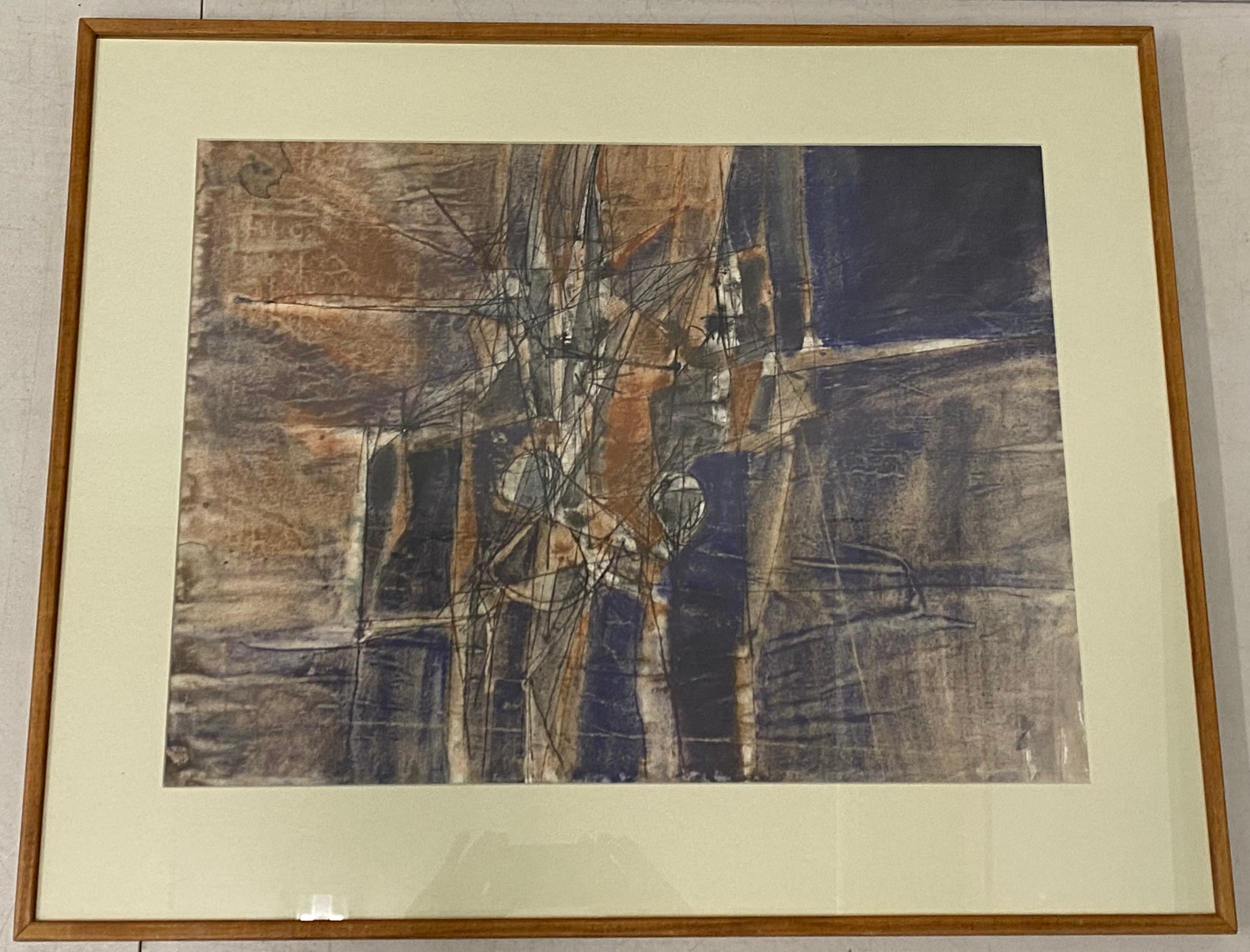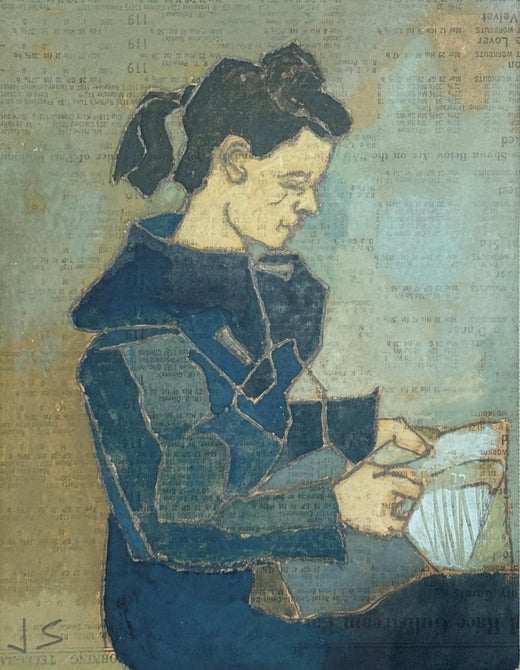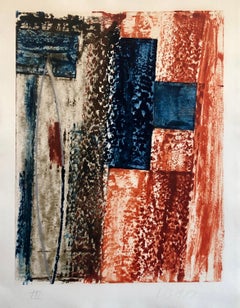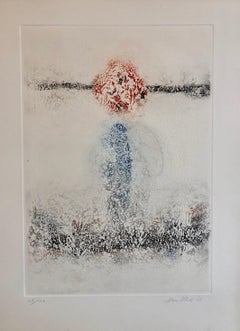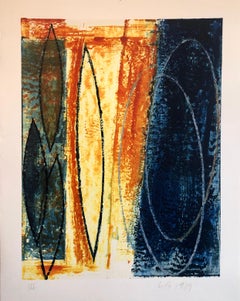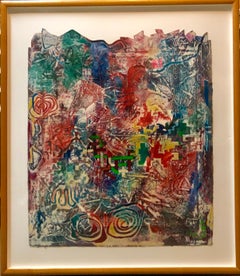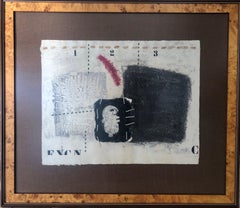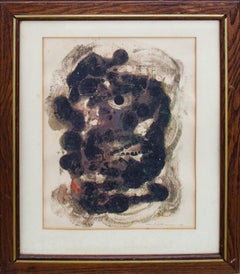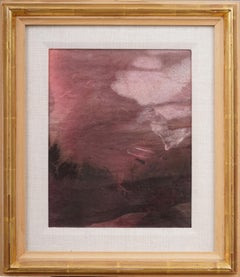Items Similar to American Abstract Color Monotype Painting Tar Cart #2 Joseph Solman WPA Artist
Want more images or videos?
Request additional images or videos from the seller
1 of 9
Joseph SolmanAmerican Abstract Color Monotype Painting Tar Cart #2 Joseph Solman WPA Artistc. 20th Century
c. 20th Century
$1,600
£1,218.96
€1,405.50
CA$2,239.17
A$2,501.90
CHF 1,308.77
MX$30,681.27
NOK 16,723.59
SEK 15,858.39
DKK 10,490.03
Shipping
Retrieving quote...The 1stDibs Promise:
Authenticity Guarantee,
Money-Back Guarantee,
24-Hour Cancellation
About the Item
"Tar Cart #2" by Joseph Solman (American, 1909-2008)
Hand signed recto
Joseph Solman (January 25, 1909 – April 16, 2008) was a Jewish American painter, a founder of The Ten, a group of New York City Expressionist painters in the 1930s. His best known works include his "Subway Gouaches" depicting travellers on the New York City Subway.
Born in Vitebsk, Belarus, Russian Empire, he was brought to America from the Russian Empire as a child in 1912, Solman was a prodigious draftsman and knew, in his earliest teens, that he would be an artist. He went straight from high school to the National Academy of Design, though he says he learned more by sketching in the subway on the way back from school late at night: people "pose perfectly when they're asleep." In 1929, Solman saw the inaugural show at the Museum of Modern Art featuring Seurat, Gauguin, Van Gogh, and Cézanne.
In 1934, Solman had his first one-man show, much influenced by the French modern artist Georges Rouault. One critic was impressed by "the mystery that lurks in deserted streets in the late twilight." Another noted that Solman's color had "an astonishingly rich quality that burns outward beneath the surface."
Joseph Solman was, with Mark Rothko, the unofficial co-leader of The Ten, a group of expressionist painters including Louis Schanker, Adolph Gottlieb, Ben Zion and Ilya Bolotowsky, who exhibited as the "Whitney Dissenters" at the Mercury Galleries in New York City in 1938. The members, all immigrant Jewish New Yorkers with an interest in European Expressionism, presented an urban, abstract, formal style. A champion of modernism, Solman was elected an editor of Art Front Magazine when its other editors, art historian Meyer Schapiro and critic Harold Rosenberg, were still partial to Social Realism. But Solman never believed in abstraction for abstraction's sake. "I have long discovered for myself," Solman has said, "that what we call the subject yields more pattern, more poetry, more drama, greater abstract design and tension than any shapes we may invent." As his colleagues in the Ten advanced toward a more non-objective art, Solman warmed toward representation. An artist in the Works Project Administration (WPA) during the depression, Solman met and worked with and befriended many great artists, like Milton Avery. “Avery had a big influence on me when I was young and working in the WPA,” said Solman. “That was a great program, I couldn’t have worked without it. It’s where I saw Paul Klee’s work, which I liked very much.” By the early 1950s, when the Abstract Expressionism he had helped to develop was the mainstream in avant garde art, he was done with it. With Edward Hopper and Jack Levine, he began a magazine called "Reality." It featured the work of figurative painters, then terribly out of fashion, but its central editorial stance was that artists should be able to paint however and whatever they liked. In writing about a purchase of a typical 1930s Solman street scene for the Wichita Museum, director Howard Wooden put it this way: "Solman has produced the equivalent of an abstract expressionist painting a full decade before the abstract expressionist movement came to dominate the American art scene, but without abandoning identifiable forms." He was part of a group of New York mostly jewish artists that included Byron Browne, Milton Avery, Stuart Davis, Alice Neel, Max Weber, Ben Shahn and many others.
In 1964, The Times, discussing his well-known subway gouaches (done while commuting to his some-time job as a racetrack pari-mutuel clerk), called him a "Pari-Mutuel Picasso." In 1985, on the occasion of a 50-year retrospective, The Washington Post wrote: "It appears to have dawned, at last, on many collectors that this is art that has already stood the acid test of time.
- Creator:Joseph Solman (1909-2008, American)
- Creation Year:c. 20th Century
- Dimensions:Height: 20.5 in (52.07 cm)Width: 16.5 in (41.91 cm)
- Medium:
- Movement & Style:
- Period:
- Condition:Minor wear and creasing commensurate with age. Please refer to photos.
- Gallery Location:Surfside, FL
- Reference Number:1stDibs: LU38215219622
Joseph Solman
Brought to America from Russia as a child in 1912, Joseph Solman was a prodigious draftsman and knew, in his earliest teens, that he would be an artist. He went straight from high school to the National Academy of Design, though he says he learned more by sketching in the subway on the way back from school late at night: people “pose perfectly when they’re asleep.” In 1929, Solman saw the inaugural show at the Museum of Modern Art featuring Seurat, Gauguin, Van Gogh, and Cezanne. It changed his life – and his art. Joseph Solman was, with Mark Rothko, the unofficial co-leader of The Ten, a group of expressionist painters who exhibited as the “Whitney Dissenters” at the Mercury Galleries in New York in 1938. A champion of modernism, Solman was elected an editor of Art Front Magazine when its other editors, art historian Meyer Shapiro and critic Harold Rosenberg, were still partial to Social Realism In 1964, The Times, discussing his well-known subway gouaches (done while commuting to his some-time job as a racetrack pari-mutuel clerk), called him a “Pari-Mutuel Picasso.” In 1985, on the occasion of a 50-year retrospective, The Washington Post wrote: “It appears to have dawned, at last, on many collectors that this is art that has already stood the acid test of time.” We had the pleasure of the meeting the artist a few times at his home which was over the original Second Avenue Deli in the East Village.
About the Seller
4.9
Platinum Seller
Premium sellers with a 4.7+ rating and 24-hour response times
Established in 1995
1stDibs seller since 2014
1,782 sales on 1stDibs
Typical response time: <1 hour
- ShippingRetrieving quote...Shipping from: Surfside, FL
- Return Policy
Authenticity Guarantee
In the unlikely event there’s an issue with an item’s authenticity, contact us within 1 year for a full refund. DetailsMoney-Back Guarantee
If your item is not as described, is damaged in transit, or does not arrive, contact us within 7 days for a full refund. Details24-Hour Cancellation
You have a 24-hour grace period in which to reconsider your purchase, with no questions asked.Vetted Professional Sellers
Our world-class sellers must adhere to strict standards for service and quality, maintaining the integrity of our listings.Price-Match Guarantee
If you find that a seller listed the same item for a lower price elsewhere, we’ll match it.Trusted Global Delivery
Our best-in-class carrier network provides specialized shipping options worldwide, including custom delivery.More From This Seller
View AllAbstract Expressionist American Modernist Oil Monotype Monoprint Painting
By Larry Brown
Located in Surfside, FL
Larry Brown
Long-time established New York painter as well as faculty member the The Cooper Union, Brown works in oil on canvas and tempera paints on paper. He deals with themes of science and universality.
EDUCATION:
1970 M.F.A. in Painting, University of Arizona
1967 BA in Painting, Washington State University
SELECT GROUP EXHIBITIONS:
Mixed Company: Women Choose Men, AIR Gallery, New York, NY
Easy Breezy, Sears-Peyton Gallery, New York, NY
From Stone and Plate: Contemporary Prints from Tamarind Institute, California State University
Change of View Tamarind Institute Gallery, Albuquerque, NM
Animal As Muse, The Norton Museum of Art, W. Palm Beach, FL
Painting--Larry Brown, Joseph Haske, David Schoffman, Helander Gallery, New York, NY
Paper Houses, David Beitzel Gallery, New York, NY
Curators Choice, Albright-Knox Art Gallery, Buffalo, NY
Current Trends in Abstraction-- Larry Brown, Bill Drew...
Category
1980s Abstract Expressionist Abstract Paintings
Materials
Monoprint, Monotype
60s American Abstract Expressionist Untitled Abstract Color Composition Etching
By Don Fink
Located in Surfside, FL
Color Abstract Expressionism aquatint etching. hand pencil signed limited edition.
Don Fink (1923-2010) was a well known and well listed Abstract Expressionist who studied at the Art Students League and the Academie Julian. He was born in Duluth , Minnesota, but later moved to Europe where he established himself as an artist. He was first based in Paris where he was a member of the "Jeune École de Paris" (with Karel Appel, Debre, Friedensreich Hundertwasser, Antoni Tapies, Dumitresco, Messagier, Zanartu , etc.) and later moved to Barcelona.
A large retrospective of his earlier works was held in Madrid in 1998 with the following promotion:
Don Fink Returns to Madrid:
American "action" painter Don Fink (b. Duluth, Minnesota, 1923) has a show at Galería Rayuela through September 25. The artist divides his time between Barcelona, Paris, and New York. This is his second exhibition in Madrid in four years. The works on view date from 1952 to 1970. Their "active" surfaces meld the arts of tattooing, calligraphy and three-dimensional terrain mapping, resulting in a meditative and rewarding experience for the viewer. The show was organized by Sebastià Janè of Barcelona and Carmen Muro of Madrid. Galería Rayuela is at Calle Claudio Coello...
Category
20th Century Abstract Expressionist Abstract Prints
Materials
Etching, Aquatint
Abstract Expressionist American Modernist Oil Monotype Monoprint Painting
By Larry Brown
Located in Surfside, FL
Larry Brown
Long-time established New York painter as well as faculty member the The Cooper Union, Brown works in oil on canvas and tempera paints on paper. He deals with themes of science and universality.
EDUCATION:
1970 M.F.A. in Painting, University of Arizona
1967 BA in Painting, Washington State University
SELECT GROUP EXHIBITIONS:
Mixed Company: Women Choose Men, AIR Gallery, New York, NY
Easy Breezy, Sears-Peyton Gallery, New York, NY
From Stone and Plate: Contemporary Prints from Tamarind Institute, California State University
Change of View Tamarind Institute Gallery, Albuquerque, NM
Animal As Muse, The Norton Museum of Art, W. Palm Beach, FL
Painting--Larry Brown, Joseph Haske, David Schoffman, Helander Gallery, New York, NY
Paper Houses, David Beitzel Gallery, New York, NY
Curators Choice, Albright-Knox Art Gallery, Buffalo, NY
Current Trends in Abstraction-- Larry Brown, Bill Drew...
Category
1980s Abstract Expressionist Abstract Paintings
Materials
Monoprint, Monotype
Large Abstract Modernist Monterey Series Mixed Media Monotype Colorful Painting
By Terence La Noue
Located in Surfside, FL
Terence La Noue was born in Hammond, Indiana in 1941. He received a Bachelor of Fine Arts from Ohio Wesleyan University in 1964. After going to Berlin as a Fulbright Meister Student ...
Category
1980s Abstract Expressionist Abstract Paintings
Materials
Paint, Mixed Media, Monotype
American Abstract Expressionist Artist Melissa Meyer Aquatint Etching
By Melissa Meyer
Located in Surfside, FL
Melissa Meyer (American, b. 1946)
1984-1987, aquatint etching in black on wove paper, hand signed print, dated, and numbered from small edition of 10.
Unframed. size: 9.75'' x 6'',...
Category
1980s Abstract Expressionist Prints and Multiples
Materials
Etching, Aquatint
Large Harry Bertschmann Swiss American Abstract Expressionist Outsider Painting
By Harry Bertschmann
Located in Surfside, FL
Harry Bertschmann (Swiss American, born 1931).
Acrylic painting on paper.
Artist signature to lower right.
Provenance: Joy Moos Gallery (this was exhibited at the Outsider Art Fair)
...
Category
20th Century Abstract Expressionist Abstract Paintings
Materials
Paper, Acrylic
You May Also Like
Untitled Carborundum color etching and collage
By James Coignard
Located in Lake Worth Beach, FL
Untitled, Carborundum color etching and collage with / string embroidery, signed and numbered 69/75, about 20x26 inches. Excellent condition.
JAMES COIGNARD (1925-2008)
Painter of S...
Category
1970s Abstract Expressionist Abstract Prints
Materials
Etching
1969 Monoprint by H. Lawrence Hoffman, Signed
Located in New York, NY
H. Lawrence Hoffman (American, 1911-1977)
Inhale Exhale, 1969
Monoprint
Sight: 19 x 15 in.
Framed: 27 1/2 x 23 1/4 x 3/4 in.
Signed and dated lower right, title inscribed verso
H. Lawrence Hoffman (23 October 1911 – 20 January 1977) was a commercial book jacket designer, illustrator,calligrapher and painter who worked in New York City. He illustrated book covers for over 25 publishing companies, including Alfred A Knopf, Pocket Books, Popular Library, Macmillan, Simon & Schuster, The Viking Press, and Random House. Over the course of his career, he illustrated over 600 book jacket covers.
Hoffman graduated from the Rhode Island School of Design (RISD) in 1934 and then completed two years of post graduate study in Commercial Art from RISD. He moved to New York City with the $200 he was awarded for winning a competition to design a coin for the 1936 300 year Rhode Island Tercentennial. He began his career as an Art Director at the A.M. Sneider Advertising Company (1938–1941) and at Immerman Art Studios (1941–?). After leaving Immerman, he worked as a free-lance artist and book illustrator for the remainder of his career. He also taught illustration and lettering at The Cooper Union (1960-1967) and was a Professor of Art at C.W. Post University (1967–1976).
Hoffman began his career doing drawings for the pulp magazine, "Thrilling Mystery Magazine...
Category
1960s Abstract Expressionist Abstract Prints
Materials
Monoprint
Robert Andrew Parker Mid Century "Abstraction" Original Watercolor C.1960
By Robert Andrew Parker
Located in San Francisco, CA
Robert Andrew Parker Mid Century "Abstraction" Original Watercolor C.1960
Watercolor dimensions 24" wide x 16" high
The frame measures 30.5" wide ...
Category
Mid-20th Century Abstract Abstract Drawings and Watercolors
Materials
Watercolor
Antique American Abstract Expressionist Vintage Signed Original Framed Painting
Located in Buffalo, NY
Antique American abstract expressionist mixed media painting by Bernyce Alpert Winick 1922-2022. Watercolor and collage paper. Signed. Framed. ...
Category
1960s Abstract Abstract Paintings
Materials
Canvas, Oil
Mid-Century Modern Abstract Monotype Print
By Toma Yovanovich
Located in Buffalo, NY
An original mid century modern abstract expressionist monotype print by American artist Toma Yovanovich.
Toma Yovanovich (1931-2016)
Yovanovich was a painter/printmaker whos...
Category
1960s Abstract Geometric Abstract Prints
Materials
Monoprint, Monotype
Antique American Abstract Expressionist Vintage Signed Original Framed Painting
Located in Buffalo, NY
Antique American abstract expressionist mixed media painting by Bernyce Alpert Winick 1922-2022. Watercolor and collage paper. Signed. Framed. I...
Category
1960s Abstract Abstract Paintings
Materials
Canvas, Oil
